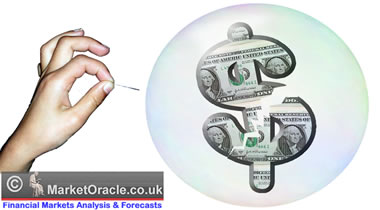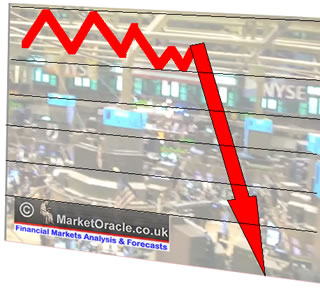Stock Market Reversal Bodes Well for U.S. Dollar
Currencies / US Dollar Oct 03, 2009 - 06:43 PM GMTBy: Bryan_Rich
 The G-7 meets this weekend in Istanbul. So what’s on the minds of these leaders of the top industrialized countries of the world?
The G-7 meets this weekend in Istanbul. So what’s on the minds of these leaders of the top industrialized countries of the world?
They’re all worried about currencies. Specifically, how currencies will impact their own recoveries and the recovery of the global economy.
The G-7’s predecessors have a history of assuming an important role in currencies. The G-10 was created to stave off attacks on the dollar and the British pound in the 1960s. And the G-5 was formed in the 1970s to try to manage the new world of flexible exchange rates.
But with new power shift to the G-20 announced last week, the G-7 might not even release a communiqué this time. What we do know, however, is that they will discuss currencies.
Since March …
- The euro has jumped 21 percent against the dollar,
- The Canadian dollar has gained 17 percent,
- The British pound has risen 16 percent,
- And the Japanese yen has climbed 11 percent.
Most of this currency strength is explained by an improving global economic picture, which has translated into general weakness in the U.S. dollar. That’s because global capital has reversed back out of the safe haven appeal of the dollar and moved to the rest of the world.
 |
| The dollar has taken a beating as investors flocked to riskier assets. |
But this dynamic has brought a sharp rise in these currencies and has become an extra threat to what is an already fragile economic recovery.
I’ve written several times in my Money and Markets columns about the mounting pressures that are building between countries as a result of the global recession and the tenuous global recovery.
As these pressures on recovery grow, there has been — and will continue to be — increasing actions to protect and defend that recovery. We’ve already seen a pick-up in protectionist activity. And we’ve already seen competitive currency devaluations, both of the verbal persuasion and via direct action. While both measures have been sworn off by G-20 members, those same member countries have been actively engaging in both.
For now, currencies represent one of the more troubling drags on economies. Governments and central bankers have poured stimulus into their economies only to have it counteracted by a strong currency. And many export-dependent countries are stuck with currencies that have been soaring against the currency of the world’s biggest consumer … the U.S. dollar.
In global trade, strong currencies put a country’s exports at a competitive disadvantage. So exporting your way out of this recession is a tough proposition. And that’s why leaders around the world have stepped up the public commentary on currencies.
Strong Dollar Speak Stepping Up …
U.S. Treasury Secretary Geithner adopted some new language on the dollar when he said: “A strong dollar is important.”
Even Fed Chairman Bernanke chimed in this week and said that “There’s no immediate risk to the dollar.”
 |
| “Sharp movements in currencies can cause adverse impacts.” — ECB president Trichet |
The president of the European Central Bank, Jean Claude Trichet, has said he’s happy to hear that the U.S. is making statements to the world about the importance of a strong dollar. He added that the strong euro has been discussed among leaders in the Eurozone.
Canada has said that the strength of the Canadian dollar could derail economic recovery. Both the central bank governor and the finance minister have verbally threatened to take action on currency strength.
And last week the Bank of England’s governor said that a weak pound helps recovery.
Then There’s Japan …
The Japanese yen has been by far the strongest major currency over the past two years. When the housing bubble in the U.S. was finally pricked, so was the global credit bubble, and so was the yen carry trade. This is where investors borrowed in yen — paying a measly interest rate — and converted that yen to currencies like the U.S. dollar, the Australian dollar and the Brazilian real where they could earn 5 percent, 10 percent … even more.
Since the top in the housing market, the yen has soared 38 percent against the dollar as hundreds of billions of dollars worth of this carry trade have been reversed. This reversal has been so powerful that the resulting yen strength explains about 55 percent of the weakness in the dollar index over the past two years.
No member of the G-7 needs healthy exports more than Japan does. But the new ruling party in Japan has given some early, mixed signals on yen strength. Now, the new Japanese Finance Minister is also giving verbal cues that Japan will take action against a strong yen if necessary.
The bottom line is that the G-7 countries would like to see a bounce in the dollar. And so would the other large stake holders in the U.S.: China, Brazil and Russia — among the largest foreign holders of Treasuries.
And it appears they just might get their wish sooner, rather than later.
Markets Flashing Warning Signals for Risk Takers …
 |
| If stocks continue their slide, the dollar could strengthen. |
The caution-laden statement out of the Federal Reserve meeting last week has so far marked a top in the risk appetite for financial markets and a bottom for the dollar.
The global proxy for recovery and investor risk appetite has been the U.S. stock market. And after generating a key technical reversal signal last week, the slide in stocks has accelerated. In an environment where risk appetite is dictating where the dollar goes, a reversal in the recent trends in financial markets bodes well for the dollar.
And a bounce in the dollar would be a welcome sign for the world and for global recovery.
Regards,
Bryan
This investment news is brought to you by Money and Markets . Money and Markets is a free daily investment newsletter from Martin D. Weiss and Weiss Research analysts offering the latest investing news and financial insights for the stock market, including tips and advice on investing in gold, energy and oil. Dr. Weiss is a leader in the fields of investing, interest rates, financial safety and economic forecasting. To view archives or subscribe, visit http://www.moneyandmarkets.com .
Money and Markets Archive |
© 2005-2022 http://www.MarketOracle.co.uk - The Market Oracle is a FREE Daily Financial Markets Analysis & Forecasting online publication.



